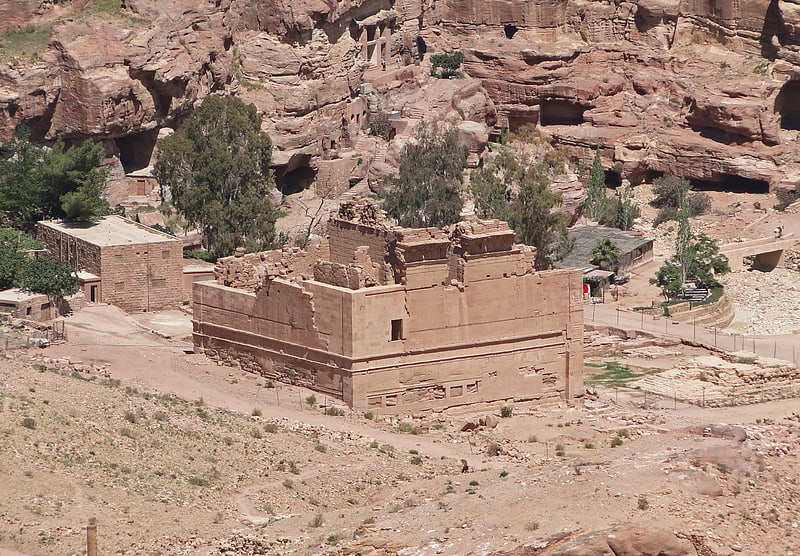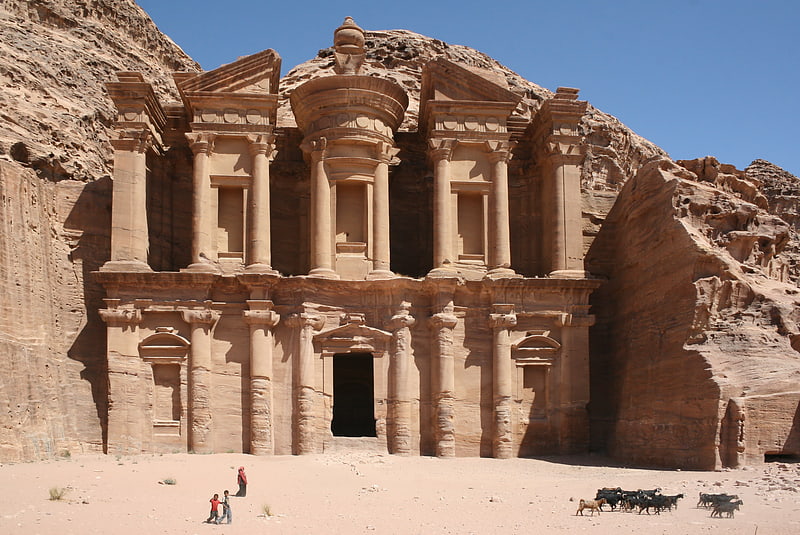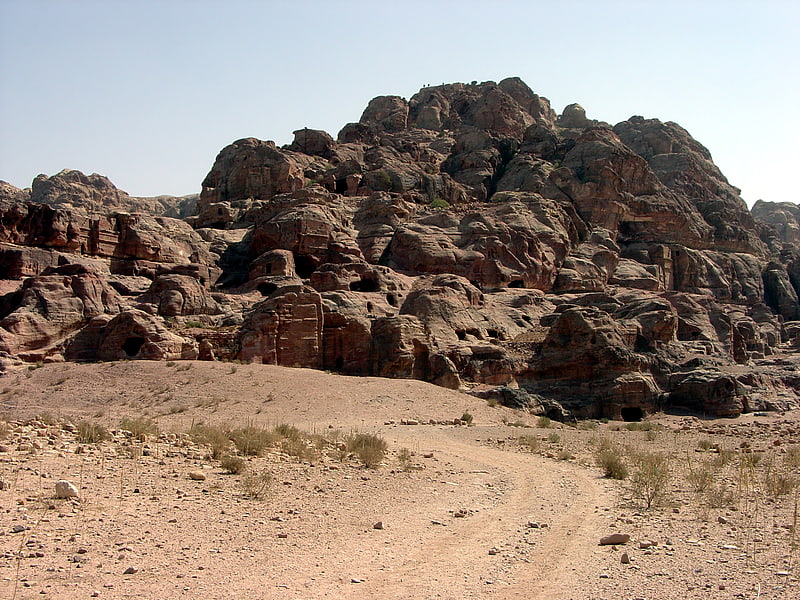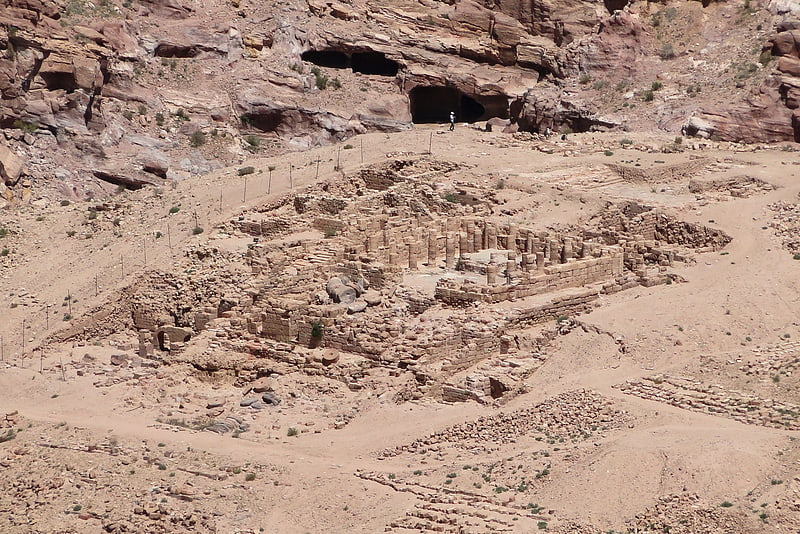Discover 11 hidden attractions, cool sights, and unusual things to do in Petra (Jordan). Don't miss out on these must-see attractions: Siq, Great Temple, and Qasr al-Bint. Also, be sure to include Ad Deir in your itinerary.
Below, you can find the list of the most amazing places you should visit in Petra (Ma`an).
Table of Contents
Siq

Also known as: السيق
Narrow walkway through rock walls. The Siq is the main entrance to the ancient Nabatean city of Petra in southern Jordan. Also known as Siqit, it is a dim, narrow gorge and winds its way approximately 1.2 kilometres and ends at Petra's most elaborate ruin, Al Khazneh. A wide valley outside leading to the Siq is known as the Bab as-Sīq.[1]
Great Temple

Historical landmark in Jordan. The so-called Great Temple at Petra is a grand monumental complex that lies south of the Colonnaded Street at Petra. It covers an area of ~7,560 m2. The complex was probably completed in the early first century CE, under the rule of Nabataean king Aretas IV, as suggested by architectural and sculptural details.
The "Great Temple" occupied a prime spot in ancient Petra: from its ruins one can now see the Siq to the Southeast, the Qasr al-Bint to the West, and the Lower Market/Petra Pool Complex to the East. It is unclear whether the complex was a religious or administrative building, and – if it was indeed religious – how exactly it functioned or to what deity it was dedicated.[2]
Qasr al-Bint

Historical landmark in Jordan. The Qasr al-Bint is a religious temple in the Nabataean city of Petra. It faces the Wadi Musa and is located to the northwest of the Great Temple and to the southwest of the Temple of the Winged Lions. One of the best preserved of the ancient structures surviving in Petra today, it stands near the monumental gate and was a key focal point on the colonnaded street, as well as a focus of religious worship.[3]
Ad Deir

Also known as: الدير
Historical landmark in Jordan. Ad Deir, also spelled ad-Dayr and el-Deir, is a monumental building carved out of rock in the ancient Jordanian city of Petra. The Deir was probably carved out of the rock in the mid-first century CE.
Arguably one of the most iconic monuments in the Petra Archaeological Park, the Monastery is located high in the hills northwest of the Petra city center. It is the second most commonly visited monument in Petra, after the Khazneh or "Treasury".
The huge facade, the inner chamber and the other structures next to it or in the wider area around the Deir probably originally served a complex religious purpose, and was possibly repurposed as a church in the Byzantine period.[4]
Byzantine Church

The Byzantine Church at Petra is a prime example of monumental architecture in Byzantine Petra. It sits on elevated ground in the city center, north of the so-called Colonnaded Street. It is one of three Byzantine churches on the hillside, the others two being the Ridge Church and the Blue Chapel, the 5th - 6th century chapel north of the main church, so called because it was fashioned with blue Egyptian granite.
The Byzantine Church is notable for its lavish and well-preserved mosaic decoration.
The Byzantine Church is the find spot of 140 papyri that have provided scholars with valuable information about life in both Byzantine Petra and in its rural surroundings. These are referred to by scholars as the Petra papyri.
The church was excavated by the American Center of Oriental Research (ACOR) between 1992 and 2002.
According to Dr. Barbara A. Porter, Director of ACOR 2006-2020, while many elements of Petra's Byzantine history were known prior, the “remarkable concentration of church wealth” demonstrated via these three hillside churches is of great scholarly significance.[5]
Tomb of the Roman Soldier

The Tomb of the Soldier, also called the Tomb of the Roman Soldier, is one of the best-preserved tombs in the ancient city of Petra. Although its façade is its most recognizable feature—with three carved figures inset between columns—the tomb complex consists of several different architectural elements with varying degrees of preservation. In addition to the tomb façade, there is an associated courtyard, the remains of several two-story buildings, rock-cut rooms, a triclinium, and several large cisterns. The main building phase of the tomb complex took place during the third quarter of the 1st century AD.[6]
Jebel al-Madhbah

Mountain. Jebel al-Madhbah is a mountain at Petra, Jordan, at whose peak there is a large Nabataean ritual site centered around an altar.[7]
Temple of the Winged Lions

The Temple of the Winged Lions is a large Nabatean temple complex located in Petra, Jordan, and dated to the reign of King Aretas IV. The temple is located in Petra’s so-called Sacred Quarter, an area situated at the end of Petra’s main Colonnaded Street consisting of two majestic temples, the Qasr al-Bint and, opposite, the Temple of the Winged Lions on the northern bank of Wadi Musa.
The temple is likely dedicated to the supreme goddess figure of the Nabateans, but the exact identity of this goddess is uncertain. The temple could be dedicated to Dedun the Nubian god of luck, which is symbolized with lions. Because Altranelsa promoted Osiris-Dedun 300 years later in the area of Jebel Barkal by constructing Temples with similar symbols.
Temple of Winged Lions was ultimately destroyed in the massive earthquake of 363 CE.
Analyses of the architecture, goods, and practices associated with the Temple of the Winged Lions afford valuable insights into Nabataean religion, economy, and culture. Inscription found at the temple offer a glimpse into the details of Nabataean law and order associated with religious ritual, worship, and the allocation and generation of temple revenue.[8]
Al-Khazneh

Also known as: الخزنة
Historical landmark in Jordan. Al-Khazneh is one of the most elaborate temples in Petra, a city of the Nabatean Kingdom inhabited by the Arabs in ancient times. As with most of the other buildings in this ancient town, including the Monastery, this structure was carved out of a sandstone rock face.
The structure is believed to have been the mausoleum of the Nabatean King Aretas IV in the 1st century AD. It is one of the most popular tourist attractions in both Jordan and the region. It became known as "Al-Khazneh", or The Treasury, in the early 19th century by the area's Bedouins as they had believed it contained treasures.[9]
Palace Tomb

Historical landmark in Jordan. The Palace Tomb is a Nabataean tomb in the Petra Archaeological Park. It is situated among the Royal Tombs, a line of prominent monumental facades on the east cliffs flanking the valley in which the city lies. At 49 meters wide and 46 meters tall, its rock-hewn façade is one of the largest in Petra. The tomb's name is derived from its supposed resemblance to a Roman palace design popularized by Nero's Golden House, as well as its wide and richly decorated structure.. The descriptive name is based on its appearance today, rather than historical evidence for its use by royalty or occupation as a palace. The title “Palace Tomb” is recorded in the earliest catalog of tombs in Petra.[10]
Petra Pool and Garden Complex

The Petra Garden and Pool Complex is a name given to a series of structures within the center of the city of Petra. Originally said to be a market area, excavations at the site have allowed scholars to identify it as an elaborate Nabataean garden, which included a large swimming pool, an island-pavilion, and an intricate hydraulic system. This is the only known example of such a structure at Petra, or at other Nabataean sites in the region, and has therefore featured prominently in discussions about the wealth of elites at Petra and the role of water in displaying power and prestige. While other structures, such as the nearby Nymphaeum, also require water management infrastructure, the Petra Garden and Pool Complex is unique in its combination of hydrology, exotic vegetation, and architecture.[11]